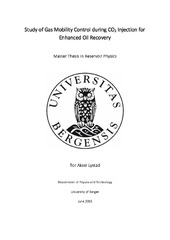| dc.description.abstract | Carbon Dioxide (CO2) has been used as a commercial source for Enhanced Oil Recovery (EOR) for over 40 years. In recent years, the utilization of anthropogenic CO2 has become more attractive, because of its proven EOR and climate mitigating capability. Despite the EOR potential, it is widely known that many CO2 injection projects are associated with inefficient gas utilization, poor macroscopic sweep efficiencies and low recoveries caused by effects of gravity segregation and viscous instabilities. Effective and affordable optimization of CO2 mobility has the potential to prolong the lifetime of existing hydrocarbon reservoirs and recover additional oil with carbon-neutral EOR activity. This thesis is part of an international collaboration, including 10 oil and service companies and 13 universities and research institutions in both USA and Europe, initiated to gain experience and confidence in utilizing CO2 for EOR. The aim for the research program is to perform laboratory studies combined with up-scaling techniques, through numerical simulation, and ultimately conduct field pilots at four confirmed onshore locations in Texas and Mississippi, United States. The experimental work conducted in this thesis investigates the use of mobility control with foam during CO2-EOR in strongly water-wet Edwards Limestone core plug samples of heterogeneous porosity and permeability. Tertiary co-injection of supercritical state CO2 and a surfactant to generate foam was conducted after a waterflood to resemble EOR projects in mature hydrocarbon reservoirs. The tertiary displacements were conducted as either CO2-foam (three experiments) or as a baseline test (one experiment) without foaming agent present. The baseline test was performed to evaluate the importance of generating foam in terms of mobility control. All co-injections were conducted at fixed liquid and gas fractions, with a total injection rate of 10 ml/h. On four stacked core systems, total oil recoveries ranged from 69.3% to 87.0% of Original Oil in Place (OOIP), with the baseline test being the most effective. Results show that additional oil recovered during the co- injections were dependent on foam stability, liquid-gas fractions and overall connectivity in the heterogeneous medium. Using Eclipse reservoir simulator, a history matching of the experimental results was performed. The simulation base model was built by collecting observed experimental liquid production data and combined with the measured core properties of core system used in the baseline test. The aim was to obtain satisfactory history match between simulated and laboratory data by conducting sensitivity parameter studies. A validated numerical model, i.e. a model that reproduce the experimental results observed, may be used for up-scaling from the laboratory scale towards the field pilot scale. It was observed that the concurrence of simulated and laboratory waterflood data was dependent on crude oil and brine relative permeabilities. | en_US |
